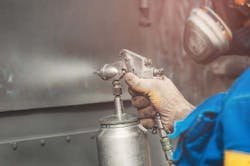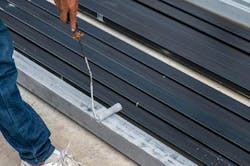Are Your Coatings Mud Cracking? Here's How To Avoid That
No one wants to apply a paint or anti-corrosion coating only to come back later and find that it has dried to look like cracked mud. Not only does the texture look bad, but it also leaves behind cracks that go down to the metal surface, making it more susceptible to corrosion.
While the problem of mud cracking can only be resolved by removing and reapplying the coating, it's very easy to prevent by following the guidelines below.
Why Does Mud Cracking Happen?
No matter how good a coating is, mud cracking can occur when the coating is applied too thickly. This is because solvents and water evaporate out of the paint at a certain rate as the coating dries. If the coating is too thick, the surface of the coating dries more quickly than the volatiles underneath. Once the surface dries, the volatiles are trapped below and the only way they can escape is by cracking the dry surface layer to get out.
While mud cracking can happen with either solvent-based or water-based coatings, it's more common in water-based coatings since water evaporates more slowly.
How Can You Prevent Mud Cracking?
The solution for preventing mud cracking is extremely simple: follow the manufacturer’s recommendations for coating thickness. The coating manufacturer already knows how the coating will behave and usually provides both a wet film thickness (WFT) and a dry film thickness (DFT) recommendation on the product data sheet.
To avoid mud cracking, the coating applicator simply needs to apply the recommended WFT, measuring coating thickness with a WFT gauge to make sure it's correct.
If only the DFT is listed, the painter can figure out the proper WFT based on the recommended DFT and the percent volume of solids. This percentage tells how much of the coating will remain after the volatiles have evaporated.
For example, an approximately 50% volume solids coating such as VpCI-395 will lose about half of its WFT by the time it dries. To get 3 mils (75 µm) DFT, the coating will need to be applied at 6 mils (150 µm) WFT.
A coating such as EcoShield VpCI-386 with a 31% volume of solids will lose a little more than two-thirds of WFT by the time it dries, meaning 9.6 mils (240 µm) WFT is needed to achieve 3 mils (75 µm) DFT.
What If You Need a Thicker Coating?
Sometimes, it's necessary to apply a thicker coating than normal. If this is the case, the painter can avoid mud cracking by applying the paint in multiple coats and allowing them to dry in between each application.
Remember to Follow Instructions!
Often the best way to achieve success is right in front of us. By following WFT recommendations on a coating’s technical data sheet, painters can avoid unnecessary problems and rework caused by mud cracking.

